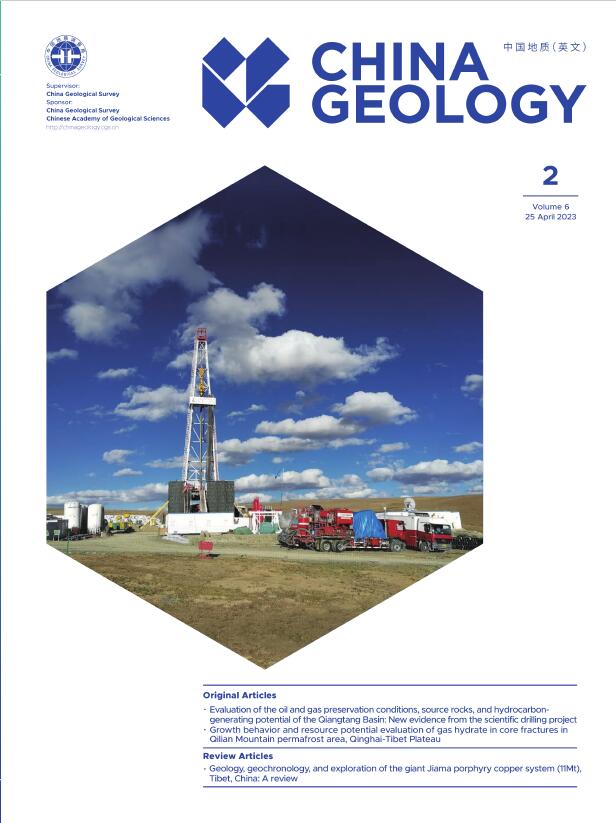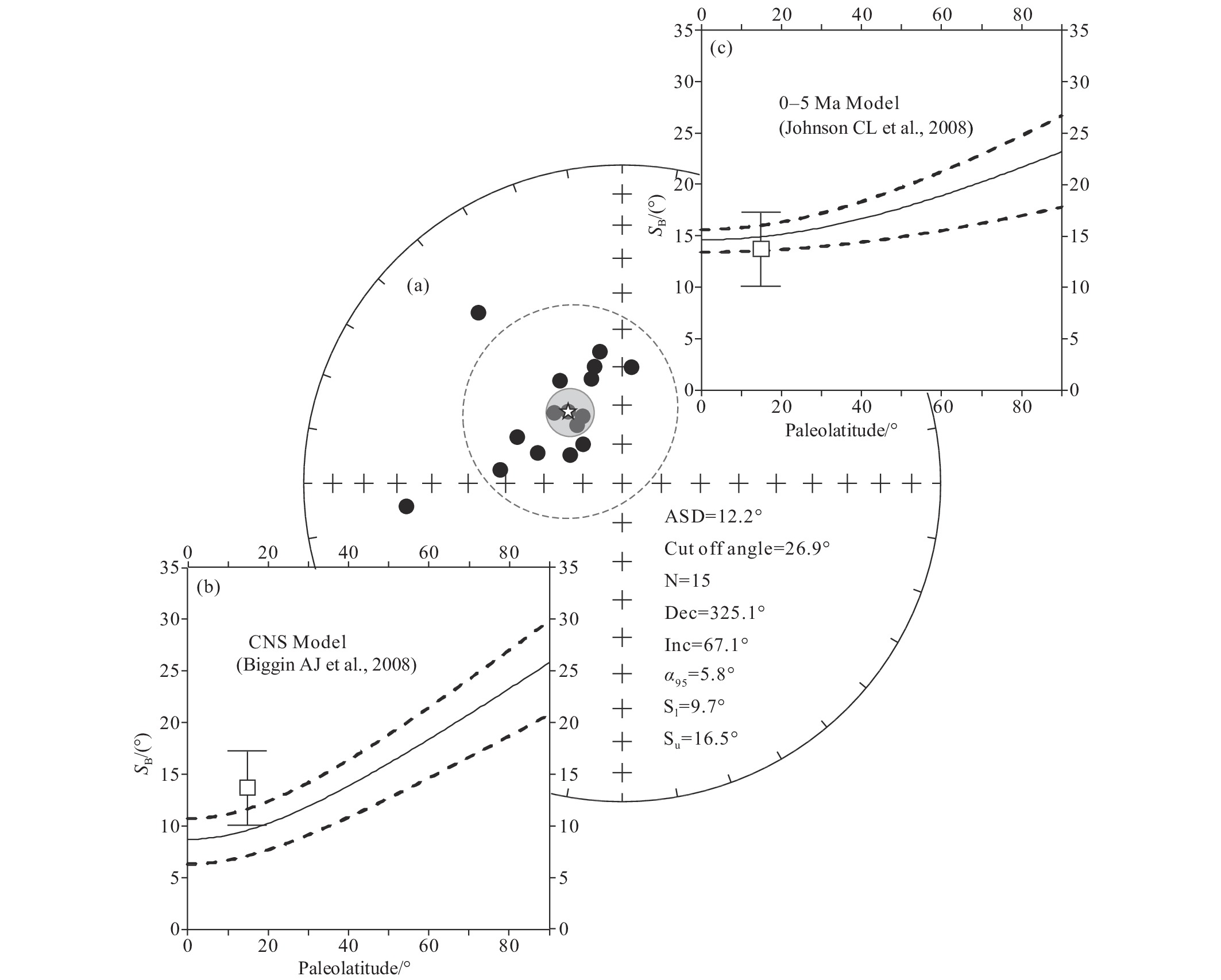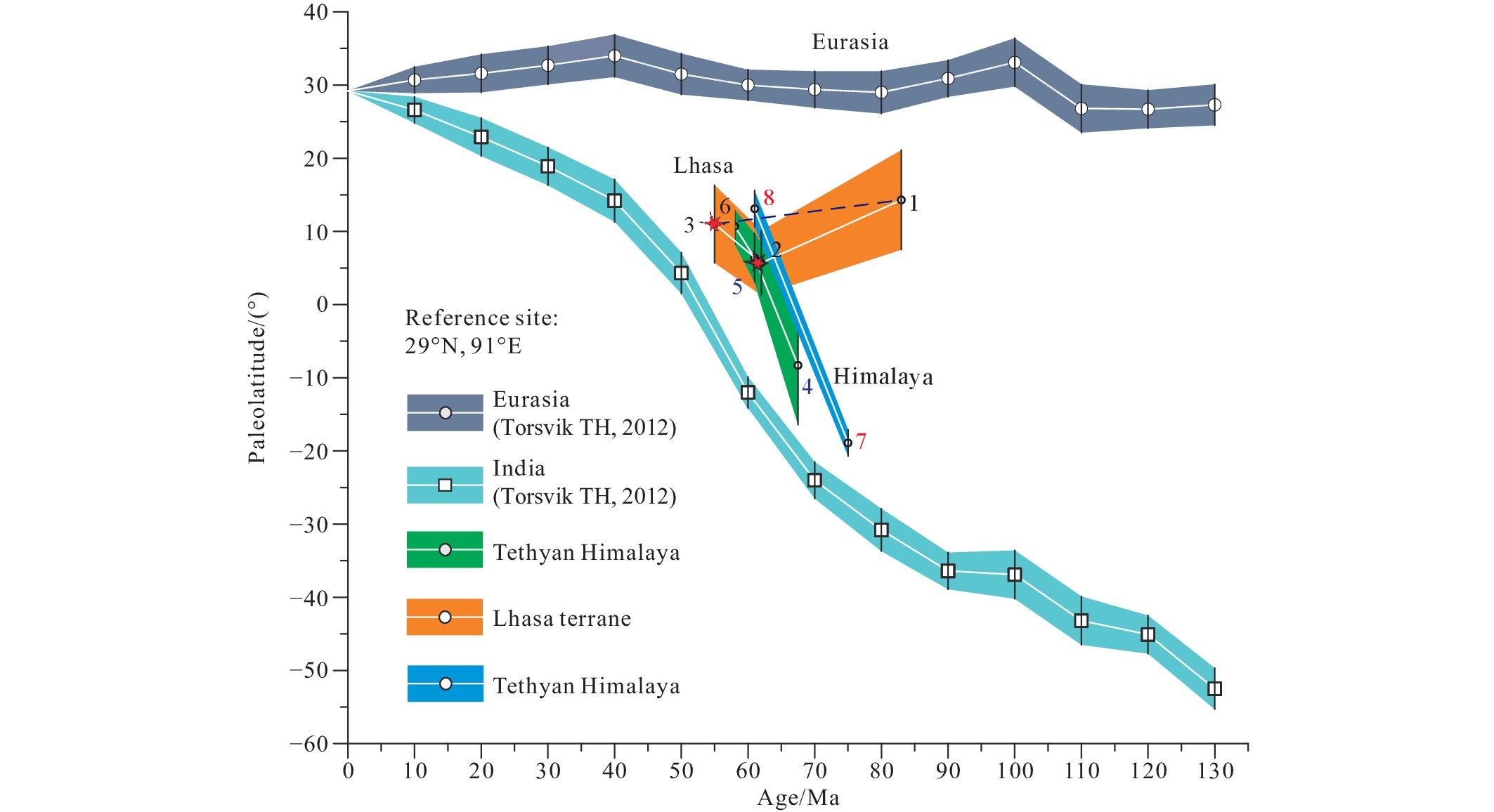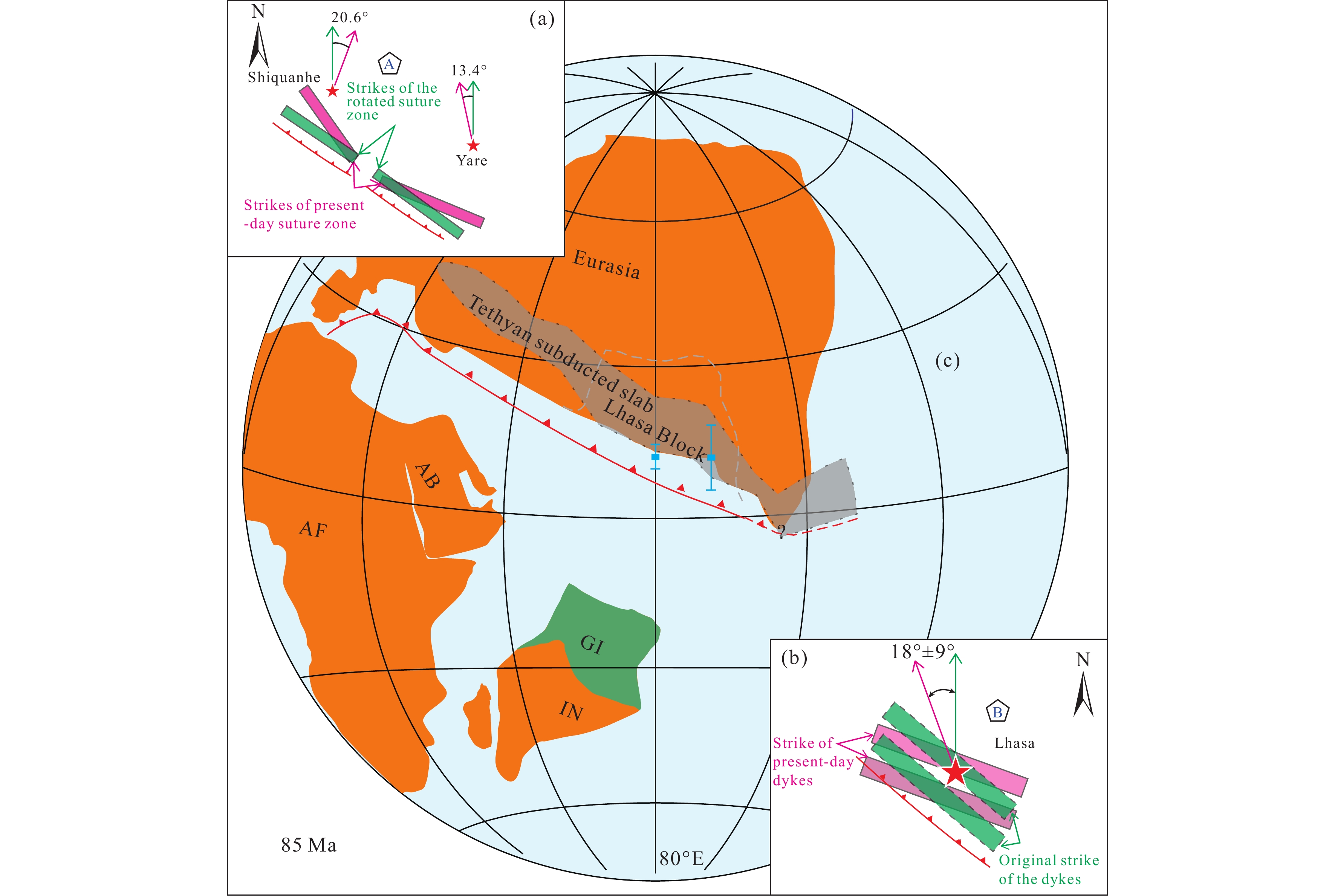| Citation: | Zhi-yu Yi, Si-lin Yang, Joseph G. Meert, Xu-xuan Ma, 2023. Paleomagnetism of late Cretaceous dykes in the Gangdese belt: New constraints on the position and structure of the southern margin of Asia prior to the India-Asia collision, China Geology, 6, 269-284. doi: 10.31035/cg2022077 |
Paleomagnetism of late Cretaceous dykes in the Gangdese belt: New constraints on the position and structure of the southern margin of Asia prior to the India-Asia collision
-
Abstract
This paper report paleomagnetic data from late Cretaceous diorite dykes that sub-vertically intrude granodiorites in the eastern Gangdese belt near the city of Lhasa. Our research goals are to provide further constraints on pre-collisional structure of the southern margin of Asia and the onset of the India-Asia collision. Magnetite is identified as the main magnetic carrier in our study. The magnetite shows no evidence of metamorphism or alteration as determined from optical and scanning electron microscope observations. A strong mineral orientation is revealed by anisotropy of magnetic susceptibility analysis both for the intruded dykes and the country rocks. The authors interpret this AMS fabric to have formed during intrusion rather than deformation. Fifteen of 23 sites yield acceptable site mean characteristic remanences with dual polarities. A scatter analysis of the virtual geomagnetic poles suggests that the mean result adequately averaged paleosecular variation. The paleomagnetic pole from the Gangdese dykes yields a paleolatitude of 14.3°N±5.8°N for the southern margin of Asia near Lhasa. The paleolatitude corresponds to an in-between position of the Lhasa terrane during about 130‒60 Ma. Furthermore, the mean declination of the characteristic remanent magnetization reveals a significant counterclockwise rotation of 18°±9° for the sampling location since about 83 Ma. In the light of tectonic setting of the dykes, the strike of the southern margin of Asia near Lhasa is restored to trend approximately about 310°, which is compatible with the hypothesis that the southern margin of Eurasia had a quasi-linear structure prior to its collision with India.
-

-
References
Achache J, Courtillot V, Xiu ZY. 1991. Paleogeographic and Tectonic evolution of southern Xizang since middle Cretaceous time: new paleomagnetic data and synthesis. Geology of the Himalayas-Papers on Geophysics, Geological Printing House, Beijing, 201‒244. Achache J, Courtillot V, Xiu ZY. 1984. Paleogeographic and tectonic evolution of southern Xizang since middle Cretaceous time-new paleomagnetic data and synthesis. Journal of Geophysical Research, 89(b12), 10311–10339. doi: 10.1029/jb089ib12p10311. Aitchison JC, Ali JR, Davis AM. 2007. When and where did India and Asia collide? Journal of Geophysical Research, 112 (B05423), 1‒12. doi:10.1029/2006jb004706. An W, Hu X, Garzanti E, Wang JG, Liu Q. 2021. New precise dating of the India-Asia collision in the Xizang Himalaya at 61 Ma. Geophysical Research Letters, 48. e2020GL090641. DOI: 10.1029/2020GL090641. Belica ME, Piispa EJ, Meert JG, Pesonen LJ, Plado J, Pandit MK, Kamenov GD, Celestino M. 2014. Paleoproterozoic mafic dyke swarms from the Dharwar craton; paleomagnetic poles for India from 2. 37 to 1. 88 Ga and rethinking the Columbia supercontinent. Precambrian Research, 244, 100–122. doi: 10.1016/j.precamres.2013.12.005. Biggin AJ, van Hinsbergen DJJ, Langereis CG, Straathof GB, and Deenen MHL. 2008. Geomagnetic secular variation in the Cretaceous Normal Superchron and in the Jurassic. Physics of the Earth and Planetary Interiors, 169(1‒4), 3‒19. doi:10.1016/j.pepi.2008.07.004. Borradaile GJ, and Jackson M. 2004. Anisotropy of magnetic susceptibility (AMS): magnetic petrofabrics of deformed rocks. Geological Society, London, Special Publications, 238(1), 299‒360. doi:10.1144/GSL.SP.2004.238.01.18. Bosboom R, Dupont-Nivet G, Huang W, Yang W, Guo Z. 2014. Oligocene clockwise rotations along the eastern Pamir: Tectonic and paleogeographic implications. Tectonics, 33(2), 53–66. doi: 10.1002/2013TC003388. Buchan KL, and Halls HC. 1990. Paleomagnetism of proterozoic mafic Dyke Swarms of the Canadian shield. Mafic Dykes and Emplacement Mechanisms. Rotterdam, Balkema, 209–230. doi: 10.1007/BF02879661. Butler RF. 1992. Paleomagnetism: Magnetic Domains to Geologic Terranes (Vol. 319). Boston, Blackwell Scientific Publications. 205-222. Cao Y, Sun Z, Li H, Pei J, Jiang W, Xu W, Zhao L, Wang L, Li C, Ye X, Zhang L. 2017. New Late Cretaceous paleomagnetic data from volcanic rocks and red beds from the Lhasa terrane and its implications for the paleolatitude of the southern margin of Asia prior to the collision with India. Gondwana Research, 41, 337–351. doi: 10.1016/j.gr.2015.11.006. Carvallo C, Dunlop DJ, Özdemir Ö. 2005. Experimental comparison of FORC and remanent Preisach diagrams. Geophysical Journal International, 162(3), 747–754. doi: 10.1111/j.1365-246x.2005.02688.x. Chen JS, Huang BC, Sun LS. 2010. New constraints to the onset of the India-Asia collision: Paleomagnetic reconnaissance on the Linzizong Group in the Lhasa Terrane, China. Tectonophysics, 489(1‒4), 189‒209. doi: 10.1016/j.tecto.2010.04.024. Chen JS, Huang BC, Yi ZY, Yang LK, Chen LW. 2014. Paleomagnetic and 40Ar/39Ar geochronological results from the Linzizong Group, Linzhou Basin, Lhasa Terrane, Xizang: implications to Paleogene paleolatitude and onset of the India-Asia collision. Journal of Asian Earth Sciences, 96, 162–177. doi: 10.1016/j.jseaes.2014.09.007. Chen Y, Cogné JP, Courtillot V, Tapponnier P, Zhu XY, 1993. Cretaceous Paleomagnetic Results from Western Xizang and Tectonic Implications. Journal of Geophysical Research: Solid Earth, 98(B10), 17981‒17999. doi:10.1029/93jb01006. Chen Y, Xu B, Zhan S, Li YG. 2004. First mid-Neoproterozoic paleomagnetic results from the Tarim Basin (NW China) and their geodynamic implications. Precambrian Research, 133(3), 271–281. doi: 10.1016/j.precamres.2004.05.002. Chung SL, Chu MF, Zhang YQ, Xie YW, Lo CH, Lee TY, Lan CY, Li XH, Zhang Q, Wang YZ. 2005. Xizang tectonic evolution inferred from spatial and temporal variations in post-collisional magmatism. Earth-Science Reviews, 68, 173–196. doi: 10.1016/J.EARSCIREV.2004.05.001. Day R, Fuller M, and Schmidt VA. 1977. Hysteresis properties of titanomagnetites: grain-size and compositional dependence. Physics of the Earth and planetary interiors, 13(4), 260–267. doi: 10.1016/0031-9201(77)90108-X. Dunlop DJ. 2002. Theory and application of the Day plot (Mrs/Ms versus Hcr/Hc) 1. Theoretical curves and tests using titanomagnetite data. Journal of Geophysical Research: Solid Earth, 107(B3), 2057–2061. doi: 10.1029/2001JB000487. Enkin RJ, Chen Y, Courtillot V, Besse J, Xing L, Zhang Z, Zhuang Z, Zhang J. 1991. A Cretaceous pole from south China, and the Mesozoic hairpin turn of the Eurasian apparent polar wander path. Journal of Geophysical Research:Solid Earth, 96(B3), 4007–4027. doi: 10.1029/90JB01904. Fisher R. 1953. Dispersion on a Sphere. London:Proceedings of the Royal Society, 295–305. doi: 10.2307/99186. Guo L, Zhang HF, Harris N, Pan FB, Xu WC. 2011. Origin and evolution of multi-stage felsic melts in eastern Gangdese belt: constraints from U-Pb zircon dating and Hf isotopic composition. Lithos, 127, 54–67. doi: 10.1016/j.lithos.2011.08.005. Guo LS, Liu YL, Liu SW, Cawood PA, Wang ZH, Liu HF. 2013. Petrogenesis of Early to Middle Jurassic granitoid rocks from the Gangdese belt, Southern Xizang: implications for early history of the Neo-Tethys. Lithos, 179, 320–333. doi: 10.1016/j.lithos.2013.06.011. Halls HC. 1978. The use of converging remagnetization circles in palaeomagnetism. Physics of the Earth and Planetary Interiors, 16(1), 1–11. doi: 10.1016/0031-9201(78)90095-X. Halls HC, Li J, Davis D, Hou G, Zhang B, Qian X. 2000. A precisely dated Proterozoic palaeomagnetic pole from the North China craton, and its relevance to palaeocontinental reconstruction. Geophysical Journal International, 143(1), 185–203. doi: 10.1046/j.1365-246x.2000.00231.x. Huang WT, Dupont-Nivet G, Lippert PC, van Hinsbergen DJ, Hallot E. 2013. Inclination shallowing in Eocene Linzizong sedimentary rocks from Southern Xizang: Correction, possible causes and implications for reconstructing the India–Asia collision. Geophysical Journal International, 194, 1390–1411. doi: 10.1093/gji/ggt188. Huang WT, Dupont‐Nivet G, Lippert PC, Hinsbergen DJ, Dekkers MJ, Guo ZJ, Waldrip R, Li XC, Zhang XR, Liu DD, Kapp P. 2015. Can a primary remanence be retrieved from partially remagnetized Eocence volcanic rocks in the Nanmulin Basin (southern Xizang) to date the India-Asia collision? Journal of Geophysical Research: Solid Earth, 120(1), 42‒66. doi: 10.1002/2014JB011599. Huang WT, Lippert PC, Jackson MJ, Dekkers MJ, Zhang Y, Li J, Guo ZJ, Kapp P, Hinsbergen DJ. 2017a. Remagnetization of the Paleogene Xizang Himalayan carbonate rocks in the Gamba area: Implications for reconstructing the lower plate in the India-Asia collision. Journal of Geophysical Research:Solid Earth, 122(2), 808–825. doi: 10.1002/2016JB013662. Huang WT, Lippert PC, Zhang Y, Jackson MJ, Dekkers MJ, Li J, Hu XM, Zhang B, Guo ZJ, Hinsbergen DJ. 2017b. Remagnetization of carbonate rocks in southern Xizang: Perspectives from rock magnetic and petrographic investigations. Journal of Geophysical Research: Solid Earth, 122(4), 2434–2456. doi: 10.1002/2017JB013987. Ji WQ, Wu FY, Chung SL, Li JX, Liu CZ. 2009. Zircon U-Pb geochronology and Hf isotopic constraints on petrogenesis of the Gangdese batholith, southern Xizang. Chemical Geology, 262, 229–245. doi: 10.1016/J.CHEMGEO.2009.01.020. Johnson CL, Constable CG, Tauxe L, Barendregt R, Brown LL, Coe RS. 2008. Recent investigations of the 0 – 5 Ma geomagnetic field recorded by lava flows. Geochemistry Geophysics Geosystems, 9(4), Q04032. doi: 10.1029/2007GC001696. Kirschvink JL. 1980. The least-squares line and plane and the analysis of Paleomagnetic data. Geophysical Journal of the Royal Astronomical Society, 62(3), 699–718. doi: 10.1111/j.1365-246X.1980.tb02601.x. Li S, Advokaat EL, van Hinsbergen DJ, Koymans M, Deng C, Zhu R. 2017. Paleomagnetic constraints on the Mesozoic-Cenozoic paleolatitudinal and rotational history of Indochina and South China: Review and updated kinematic reconstruction. Earth-Science Reviews, 2017, S0012825217300247. doi: 10.1016/j.earscirev.2017.05.007. Liang YL, Huang BC, Yi ZY, Zhang Y, Yan YG, Zhang DH. 2017. Reconnaissance of pre-collisional paleolatitudes of the southern margin of Eurasia: New paleomagnetic results from Upper Cretaceous red beds in the Linzhou Basin, Xizang. Chinese Journal of Geophysics, 60(5), 1811–1824. doi: 10.6038/cjg20170517. Liebke U, Appel E, Ding L, Neumann U, Antolin B, Xu Q. 2010. Position of the Lhasa terrane prior to India–Asia collision derived from palaeomagnetic inclinations of 53 Ma old dykes of the Linzhou Basin: constraints on the age of collision and post-collisional shortening within the Xizang Plateau. Geophysical Journal International, 182(3), 1199–1215. doi: 10.1111/j.1365-246X.2010.04698.x. Lin J, Watts DR. 1988. Palaeomagnetic results from the Xizang Plateau. Philosophical Transactions of the Royal Society A, 327, 239–262. doi: 10.1098/rsta.1988.0128. Liu Z, and Buck WR. 2021. Magmatic sill formation during dike opening. Geology, 50(4), 407–411. doi: 10.1016/j.jvolgeores.2014.05.018. Lippert PC, van Hinsbergen DJJ, Dupont-Nivet G. 2014. The early Cretaceous to present latitude of the central Lhasa-plano (Xizang): A paleomagnetic synthesis with implications for Cenozoic tectonics, paleogeography and climate of Asia, in: Nie JS. , Hoke GD. and Horton BK. (editors), Geological Society of America Special Paper: Towards an improved understanding of uplift mechanisms and the elevation history of the Xizang plateau: Boulder, Co, Geological Society of America, p. 1‒21,doi: 10.1130.2014.2507(01). Ma L, Wang Q, Wyman DA, Li ZX, Jiang ZQ, Yang JH, Gou GN, Guo HF. 2013. Late Cretaceous (100–89 Ma) magnesian charnockites with adakitic affinities in the Milin area, eastern Gangdese: partial melting of subducted oceanic crust and implications for crustal growth in southern Xizang. Lithos, 175‒176, 315‒332. doi: 10.1016/j.lithos.2013.04.006. Ma X, Xu Z, and Meert JG. 2017. Syn-convergence extension in the southern Lhasa terrane: Evidence from late Cretaceous adakitic granodiorite and coeval gabbroic-dioritic dykes. Journal of Geodynamics, 110, 12–30. doi: 10.1016/j.jog.2017.07.004. Ma Y, Yang T, Bian W, Jin J, Wang Q, Zhang S, Wu H, Li H, Cao L, Yuan H, and Ding J. 2017. Paleomagnetic and geochronologic results of latest Cretaceous lava flows from the Lhasa Terrane and their tectonic implications. Journal of Geophysical Research:Solid Earth, 122, 8786–8809. doi: 10.1002/2017JB014743. Ma Y, Wang Q, Yang T, Ou Q, Zhang X, Dan W, Zhang S, Wu H, Li, Cao L, Wang J. 2022. Location of the Lhasa terrane in the Late Cretaceous and its implications for crustal deformation. Palaeogeography, Palaeoclimatology, Palaeoecology, 588, 110821. doi: 10.1016/j.palaeo.2021.110821. McFadden PL, McElhinny MW. 1990. Classification of the reversal test in palaeomagnetism. Geophysical Journal International, 103(3), 725–729. doi: 10.1111/j.1365-246X.1990.tb05683.x. Morris A, Maffione M. 2016. Is the Troodos ophiolite (Cyprus) a complete, transform fault–bounded Neotethyan ridge segment? Geology, 44(3), 199‒202. doi: 10.1130/G37529.1. Muxworthy AR, Roberts AP. 2007. First-order reversal curve (FORC) diagrams. in Encyclopedia of Geomagnetism and Paleomagnetism, edited by D. Gubbins, and E. Herrero-Bervera, Springer, New York. doi: 10.1007/978-1-4020-4423-6_99. Najman Y, Appel E, Boudagher‐Fadel M, Bown P, Carter A, Garzanti E, Godin L, Han J, Liebke U, Oliver G, Parrish R. 2010. Timing of India-Asia collision: Geological, biostratigraphic, and palaeomagnetic constraints. Journal of Geophysical Research: Solid Earth, 115(B12). doi: 10.1029/2010jb007673. Patriat P, Achache J. 1984. India–Eurasia collision chronology has implications for crustal shortening and driving mechanism of plates. Nature, 311(5987), 615–621. doi: 10.1038/311615a0. Patzelt A, Li H, Wang J, Appel E. 1996. Palaeomagnetism of Cretaceous to Tertiary sediments from southern Xizang: evidence for the extent of the northern margin of India prior to the collision with Eurasia. Tectonophysics, 259(4), 259–284. doi: 10.1016/0040-1951(95)00181-6. Pozzi JP, Westphal M, Zhou YX, Xing LS, Chen XY, 1982. Position of the Lhasa Block, South Xizang, during the Late Cretaceous. Nature, 297(5864), 319‒321. doi: 10.1038/297319a0. Replumaz A, Negredo AM, Villasenor A, Stéphane G. 2010. Indian continental subduction and slab break-off during Tertiary collision. Terra Nova, 22(4), 290–296. doi: 10.1111/j.1365-3121.2010.00945.x. Replumaz A, Tapponnier P. 2003. Reconstruction of the deformed collision zone between India and Asia by backward motion of lithospheric blocks. Journal of Geophysical Research: Solid Earth, 108(B6), 1978‒2012. doi: 10.1029 /2001jb000661. Replumaz A, Guillot S, Villaseñor A, Negredo AM. 2013. Amount of Asian lithospheric mantle subducted during the India/Asia collision. Gondwana Research, 24(3–4), 936‒945. doi: 10.1016/j.gr.2012.07.019. Roberts AP, Pike CR, Verosub KL. 2000. First-order reversal curve diagrams: A new tool for characterizing the magnetic properties of natural samples. Journal of Geophysical Research:Solid Earth, 105(B12), 28461–28475. doi: 10.1046/j.0956-540x.2001.01419.x. Schärer U, Allègre CJ. 1984. U-Pb geochronology of the Gangdese (Transhimalaya) plutonism in the Lhasa-Xigaze region, Xizang. Earth and Planetary Science Letters 63, 423–432. doi: 10.1016/0012-821X(84)90190-0. Sun Z, Pei J, Li H, Xu W, Jiang W, Zhu Z, Wang X, Yang Z. 2012. Palaeomagnetism of late Cretaceous sediments from southern Xizang: Evidence for the consistent palaeolatitudes of the southern margin of Eurasia prior to the collision with India. Gondwana Research, 21(1), 53–63. doi: 10.1016/j.gr.2011.08.003. Sun Z, Jiang W, Li H, Pei J, Zhu Z. 2010. New paleomagnetic results of Paleocene volcanic rocks from the Lhasa block: Tectonic implications for the collision of India and Asia. Tectonophysics, 490(3‒4), 257‒266. doi: 10.1016/j.tecto.2010.05.011. Tan X, Kodama KP. 2002. Magnetic anisotropy and paleomagnetic inclination shallowing in red beds: Evidence from the Mississippian Mauch Chunk Formation, Pennsylvania. Journal of Geophysical Research, 107(B11), 2311. doi: 10.1029/2001JB001636. Tan X, Gilder S, Kodama KP, Jiang W, Han Y, Zhang H, Xu H, Zhou D. 2010. New paleomagnetic results from the Lhasa block: Revised estimation of latitudinal shortening across Xizang and implications for dating the India-Asia collision. Earth and Planetary Science Letters, 293(3‒4), 396‒404. doi: 10.1016/j.jpgl.2010.03.013. Tauxe L. 2005. Inclination flattening and the geocentric axial dipole hypothesis. Earth and Planetary Science Letters, 233(3‒4), 247‒261. doi: 10.1016/j.jpgl.2005.01.027. Tong Y, Yang Z, Pei J, Wang H, Xu Y, Pu Z. 2017. Paleomagnetism of the Upper Cretaceous red-beds from the eastern edge of the Lhasa Terrane: New constraints on the onset of the India-Eurasia collision and latitudinal crustal shortening in southern Eurasia. Gondwana Research, 48, 86–100. doi: 10.1016/j.gr.2017.04.018. Tong Y, Yang Z, Pei J, Li J, Jin S, Hou L, Sun X, Zhang Z. 2022. New Late Cretaceous paleomagnetic results from the Lhasa terrane and their implications for the suturing of India and Eurasia and the closure of the Neo-Tethys Ocean. Bulletin, 134(11‒12), 3242‒3257. https://doi.org/10.1130/B36310.1. Torsvik TH, Van der Voo R, Preeden U, Mac Niocaill C, Steinberger B, Doubrovine PV, van Hinsbergen DJ, Domeier M, Gaina C, Tohver E. Meert JG. 2012. Phanerozoic polar wander, palaeogeography and dynamics. Earth-Science Reviews, 114(3), 325–368. doi: 10.1016/j.earscirev.2012.06.007. Van der Voo R, Spakman W, Bijwaard H. 1999. Tethyan subducted slabs under India. Earth and Planetary Science Letters, 171(1), 7‒20. doi: 10.1016/s0012-821x(99)00131-4. van Hinsbergen DJJ, Lippert PC, Dupont-Nivet G, McQuarrie N, Doubrovine PV, Spakman W, Torsvik TH. 2012. Greater India Basin hypothesis and a two-stage Cenozoic collision between India and Asia. Proceedings of the National Academy of Sciences, 109(20), 7659–7664. doi: 10.1073/pnas.1117262109. Vandamme D. 1994. A new method to determine paleosecular variation. Physics of the Earth and Planetary Interiors, 85(1‒2), 131‒142. doi: 10.1016/0031-9201(94)90012-4. Wang C, Ding L, Zhang LY, Kapp P, Pullen A, Yue YH. 2016. Petrogenesis of Middle–Late Triassic volcanic rocks from the Gangdese belt, southern Lhasa terrane: Implications for early subduction of Neo-Tethyan oceanic lithosphere. Lithos, 262, 320–333. doi: 10.1016/j.lithos.2016.07.021. Wang JG, Hu X, Garzanti E, Boudagher-Fadel MK, Liu ZC, Li J, Wu FY. 2020. From extension to tectonic inversion: Mid-Cretaceous onset of Andean-type orogeny in the Lhasa block and early topographic growth of Xizang. GSA Bulletin, 132(11‒12): 2432‒2454. doi: 10.1130/B35314.1. Westphal M, Pozzi JP. 1983. Paleomagnetic and Plate Tectonic Constraints on the Movement of Xizang. Tectonophysics, 98(1‒2), 1‒10. doi: 10.1016/0040-1951(83)90207-X. Xu WC, Zhang HF, Luo BJ, Guo L, Yang H. 2015. Adakite-like geochemical signature produced by amphibole-dominated fractionation of arc magmas: An example from the Late Cretaceous magmatism in Gangdese belt, south Xizang. Lithos, 232, 197–210. doi: 10.1016/j.lithos.2015.07.001. Yi ZY, Huang BC, Chen JS, Chen LW, Wang HL. 2011. Paleomagnetism of early Paleogene marine sediments in southern Xizang, China: Implications to onset of the India-Asia collision and size of Greater India. Earth and Planetary Science Letters, 309(1‒2), 153‒165. doi: 10.1016/j.jpgl.2011.07.001. Yi ZY, Huang B, Yang L, Tang X, Yan Y, Qiao Q, Zhao J, Chen L. 2015. A quasi‐linear structure of the southern margin of Eurasia prior to the India‐Asia collision: First paleomagnetic constraints from Upper Cretaceous volcanic rocks near the western syntaxis of Xizang. Tectonics, 34(7), 1431–1451. doi: 10.1002/2014TC003571. Yi ZY, Liang Y, Zhao J, Yan Y, Chen L, Tang X. 2016. Paleogeography of the Northern Margin of India continent prior to its collision: An investigation of the Late Cretaceous limestones in South Xizang. Acta Geologica Sinica, 90(11), 3282–3292. Yi ZY, Appel E, Huang B. 2017. Comment on “Remagnetization of the Paleogene Xizang Himalayan carbonate rocks in the Gamba area: Implications for reconstructing the lower plate in the India‐Asia collision” by Huang et al. Journal of Geophysical Research:Solid Earth, 122(7), 4852–4858. doi: 10.1002/2017JB014353. Yi ZY, Wang T, Meert JG, Zhao Q, Liu Y. 2021. An initial collision of India and Asia in the equatorial humid belt. Geophysical Research Letters, 48(9), e2021GL093408. doi: 10.1029/2021GL093408. Yuan J, Yang Z, Deng C, Krijgsman W, Hu X, Li S, Shen Z, Qin H, An W, He H, Ding L. 2021. Rapid drift of the Tethyan Himalaya terrane before two-stage India-Asia collision. National Science Review, 8(7), 173. doi: 10.1093/nsr/nwaa173. Zhang X, Chung SL, Lai YM, Ghani AA, Murtadha S, Lee HY, Hsu CC. 2019. A 6000-km-long Neo-Tethyan arc system with coherent magmatic flare-ups and lulls in South Asia. Geology, 47(6), 573–576. doi: 10.1130/G46172.1. Zhao Q, Huang B, Yi Z, Xue P. 2021. High-Resolution PetrographicEvidence Confirming Detrital and Biogenic Magnetites as Remanence Carriersfor Zongpu Carbonates in the Gamba Area, South Xizang. Earth Science Frontiers 9, 713469. doi: 10.3389/feart.2021.713469. Zhou S, Mo X, Dong G, Zhao Z, Qiu R, Guo T, Wang L. 2004. Ar-40/Ar-39 geochronology of Cenozoic Linzizong volcanic rocks from Linzhou Basin, Xizang, China, and their geological implications. Chinese Science Bulletin, 49, 1970–1979. doi: 10.1360/03wd0511. Zhu DC, Zhao ZD, Niu YL, Dilek Y, Hou ZQ, Mo XX. 2013. The origin and pre-Cenozoic evolution of the Xizang plateau. Gondwana Research, 23, 1429–1454. doi: 10.1016/j.gr.2012.02.002. Zhu R, Laj C, and Mazaud A. 1994. The Matuyama-Brunhes and Upper Jaramillo transitions recorded in a loess section at Weinan, north-central China. Earth and Planetary Science Letters, 125(1-4), 143–158. doi: 10.1016/0012-821X(94)90212-7. Zhu XY, Liu C, Ye SJ, Lin JL. 1977. Remanence of red beds from Linzhou, Xizang and the northward movement of the Indian plate. Chinese Journal of Geology, 1, 44–51. Zhu ZW, Zhu XY, Zhang YM. 1981. Paleomagnetic observation in Xizang and continental-drift. Acta Geophysica Sinica, 24(1), 40–49. Zijderveld JDA. 1967. AC demagnetization of rocks: Analysis of results. Methods in Palaeomagnetism, 254–286. doi: 10.1016/B978-1-4832-2894-5.50049-5. -
Access History

-
Figure 1.
a–Tectonic framework of the Lhasa Terrane and adjacent area (after Enkin RJ et al., 1991); b–simplified regional geologic map of the Gangdese magmatic arc near Lhasa showing distribution of the Mesozoic and Cenozoic rock units and paleomagnetic sampling locations.
-
Figure 2.
Field photos showing distribution of the sampling sites (b) and contacts between the diorite dykes and the country rock (a); plot of the bedding attitutes of sampled diorite dykes (c).
-
Figure 3.
Optical petrography (a, c) and scanning electron microscope (SEM) observations (b, d) on the thin sections from the diorite dykes (c, d) and granodiorite country rock (a, b) indicate the magnetic minerals are magnetite or titanomagnetite which have not experienced visible alteration. Mineral orientation with insignificant deformation can be observed in (d). Abbreviations: Mag‒Magnetite. See text for more information.
-
Figure 4.
Stereoplots of three principal axes of anisotropy of magnetic susceptibility (AMS) ellipsoid in geographic (a) and paleogeographic (b) systems and plots of AMS degree (Pj) versus total susceptibility (c) and AMS shape (T) (d) respectively. The pilot samples marked with red color are from granodiorite country rocks and the others are from dykes; the grey dashed arc in (a) represents the mean bedding plane of the dykes.
-
Figure 5.
Representative results of hysteresis loops of the pilot samples from the diorite dykes (a‒g) and granodiorite country rock (h) with maximum field of 0.4 to 1.0 Tesla. Acquisition of isothermal remanent magnetization (IRM), back-field demagnetization curves (in the second quadrant of each diagram) with maximum fields of 0.5 T. (i) Day plot (Day R et al., 1977; Dunlop DJ, 2002) of hysteretic parameters calculated from (a‒h) showing magnetic particles are plotted within the pseudo-single domain (PSD) range; (j) Representative FORC measurement showing magnetic particles are dominant by larger PSD or MD particles, see text for more explanation.
-
Figure 6.
Orthogonal (Zijderveld) vector plots of representative specimens from the dykes (a‒e, g‒i) and the country rock (f). Directions are plotted in-situ; open and solid circles represent vectors and endpoints projected onto horizontal and vertical planes, respectively.
-
Figure 7.
Equal-area projections of site-mean directions of the ChRMs before and after tilt-correction for the diorite dykes and granodiorite country rocks from the Gangdese Belt, southern Xizang. Solid/open symbols represent downward/upward inclinations; stars indicate the overall mean directions with 95% confidence limits.
-
Figure 8.
Virtual geomagnetic poles (VGPs) of site-mean directions (stratigraphic coordinate) on equal-area projections. The VGP cutting-off is based on Vandamme D (1994). ASD–angular standard deviation; N–number of the VGPs; Dec–magnetic declination; Inc–magnetic declination; a95–95% confidence interval of the mean paleomagnetic pole; SB–the dispersion of VGPs and its lower (Sl) and upper (Su) limits.
-
Figure 9.
Comparison of paleolatitudes of India, Eurasia, Himalayas, and Lhasa since late Cretaceous. The numbers 1, 2, 3 represent paleolatitudes for the Lhasa terrane obtained from the Gangdese pluton (dykes and country rock), Dianzhong (Yi ZY et al., 2021 compiled from Chen JS et al., 2010; 2014 and Huang WT et al., 2015) and Nianbo (Chen JS et al., 2010, 2014; Liebke U et al., 2010; Sun ZM et al., 2010) formations, whilst the numbers 4, 5, 6 indicate paleolatitudes for the Himalayas otained from the Zongshan (Yi ZY et al., 2016 revised from Patzelt A et al., 1996), lower Zongpu and upper Zongpu (Yi ZY et al., 2011) formations; Number 7 and 8 represent paleolatitude resolved from the Cailangba (Jiangzi) and Mubala (Saga) sections (Yuan J et al., 2021). See text for more explanations.
-
Figure 10.
(a) Reconstructions of the southern margin of Eurasia prior to the India-Asia collison (about 85 Ma). Precollisional positions of the southern margin of Asia in its western and eastern segments are constrained by paleomagnetic data from Yi ZY et al. (2015) and this study, respectively. The precollisional strike of the southern margin of Asia at about 80°E (b) is restored on paleomagnetic data obtained from the late Cretaceous volcanic rocks in the Shiquanhe and Yare basins according to Yi ZY et al. (2015) ; the precollisional strike of the southern margin of Asia at about 90°E (c) is inferred from the original strike of the late Cretaceous dykes (this study) in consideraion that the dykes were generated by an arc-paralelled extension caused by Neo-Tethys subduction in the late Cretaceous (Ma XX et al., 2017). solid lines and arrows in green in (b) and (c) were restored by aligning the documented declinations (solid lines and arrows in green) to the geographic north; Eurasia, Africa, Arabia and India in (a) are positioned in accordance with the APW path of Torsvik TH et al. (2012); the Neo-Tethyan subducted slab is constructed according to Van der Voo et al. (1999). Abbreviations: IN‒India; GI‒“Greater India”; AB‒Arabia; AF‒Afrian. The “Greater India” of about 1500 km is defined according to Yi ZY et al. (2011).





 DownLoad:
DownLoad:








